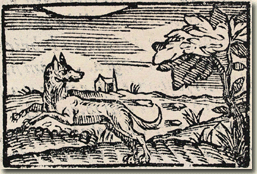The ancients, asserts Vincenzo Cartari in
his most popular manual on mythography, depicted the year
with two-faced
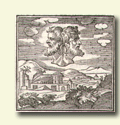 Janus.
One of the faces looked ahead to the
future, while the other looked back on the past. Janus.
One of the faces looked ahead to the
future, while the other looked back on the past.
Therefore, if we ended our Silva last
year with
a dog looking expectantly at his
master, let us reopen the Silva with another dog looking
back towards... well, let us say also towards his master. But before
considering the master, let us examine the
pedigree of this dog.
Every running dog turning
its head backwards was once a running dog looking forward. To the right we can see how our dog
might look in this hypothetical pose,
as it appears in the illustration from the Thierbuch of Conrad Gesner, the
patriarch of all illustrated natural histories.
The Thierbuch, as the
complete title announces, contained “the living and true portraits” of
animals, capturing them in the Lessingian “pregnant moment”,
in the middle of their most characteristic movement, in the
revealing epiphany of the essence of the species.
It is no surprising,
therefore, that this
representation – which was meant to
depict specifically the English foxhound – would be adopted by later natural histories as the portrait of the
species Canis in general.
This is how we find it, for example,
in the German translation of Albertus Magnus’ De
animalibus, or in the illustrated
Frankfurt edition with commentary of Pliny’s Naturalis historia.
In
this latter book it is clear that the illustration
of the wolf was also based on the model of the running
dog, instead of taking it from the more static picture of Gesner’s
wolf.
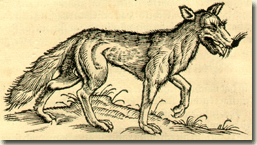
Wolf from Gesner’s Thierbuch, 1556
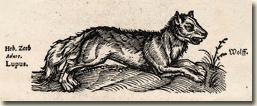
Wolf from Pliny’s Bücher..., 1565
adjusted to the scheme
of the running dog
And in the genealogical tree of Gesner’s
running dog we also find, alongside the more or less legitimate
heirs of the illustrated natural histories, more spurious
offspring as well, including in emblem books.
In Emblems 1.37 and 1.38 of
the Empresas espirituales y morales of Juan Francisco
de Villava, for example, we see a metamorphosis similar to that
of Pliny’s Bücher, with the difference that the
familiar scheme of the running dog has been transformed here
into the
running lion – and the same thing happens with a running pig
and a running deer in Part 2 of this same book (Emblems 2.27 and
2.33)!
Emblem 1.21 of Sebastián de
Covarrubias’ Emblemas morales illustrates
the exemplum of the dog drinking hastily from the water
of the Nile and
suddenly running away, fearful of the crocodiles – as
Pliny recounted.
The pictura, however, does not
represent either the Nile, nor the crocodile, as does, for
example, Johannes Sambucus, in the emblem that he dedicates to the same
topic (copied later by Geoffrey Whitney).
While Sambucus
inserts his Gesnerian dog in the middle of the context of Pliny’s
tale (in a somewhat absurd position, since it looks like it is
about to jump straight into the open mouth of the crocodile), in Covarrubias
only the running dog is seen, as a simple graphic abbreviation
of the story.
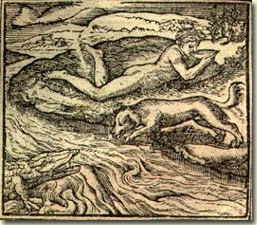
Johannes Sambucus, Emblem 28
(Sobrie potandum)
Sebastián de Covarrubias y
Horozco’s brother, Juan de Horozco y Covarrubias goes one step
further in his Symbola sacra, and adds an even more original shift to the
Idealtypus of the running dog.
Here the animal represents our
sins, which, if expelled, depart from our side but, just like dog,
at the first call for them to return they hasten to come back
and join us, their masters.
And the pictura with the dog that turns
its head backwards, with that markedly Egyptian profile and
profile, aligns perfectly with the moral interpretation to
create an ideal
Renaissance hieroglyph.
|
| |
Vincenzo Cartari, Le imagini de i dei de gli antichi, Venice 1571,
49.
Mostrano anchora le due faccie di Giano il tempo, che tuttauia
uiene: e perciò l’una è giouine, e quello che già è passato, onde
l’altra è di maggiore età, e barbuta. Plinio scriue che Numa Re de
Romani fece una statoa di Giano con le dita delle mani acconcie in
modo che mostrauano 365. accioche si conoscesse percio che egli era
il Dio dell’anno; perche l’anno ha tanti dì, quanti ei ne mostraua
con le mani: conciosia che gli antichi piegando le dita, o
stendendole in diuersi modi mostrassero tutti i numeri che uoleuano,
come si po uedere appresso del beato Beda, che ne fa un libretto. E
Suida parimente riferisce, che per mostrare Giano essere il
medesimo, che l’anno gli posero alcuni nella destra mano 300. e 65.
nella sinistra, e che altri gli diedero la chiaue nella destra per
farlo conoscere principio del tempo, e portinaio dell’anno.
Conrad
Gesner, Thierbuch, das ist Ausführliche beschreibung vnd lebendige
ja auch eigentliche Contrafactur vnd Abmahlung aller Vierfüssigen
thieren, Heidelberg 1556
Von dem Britannischen Schmeckhund. (Canis Britannicus. Sagax. Ein
Brack. Ein Schottischer wasser Hund. Ein Rache.)
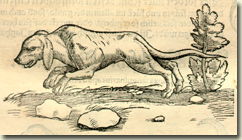
DIses ist auch ein besondere arde der Schmeckhunden, dann er nit
allein die vögel, wilden Thier mit seinem geschmack erzeigt vnd
nachhalt, sonder auch die fisch in den wasseren, zwischen den velsen
vnd schropffen, vnnd das mit seines geruchs eigenschafft.
Albertus Magnus, Thierbuch, Frankfurt 1565
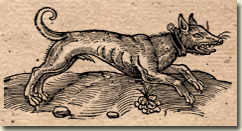
Pliny, Bücher vnd Schrifften von der Natur, Frankfurt 1565, p. 200.
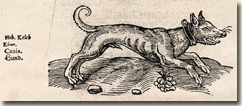
Juan Francisco de Villava, Empresas espirituales y morales, Baeza
1613, Emblems 1.37 and 1.38

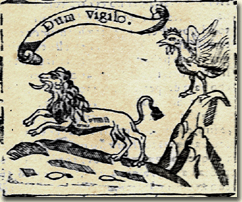
Sebastián de Covarrubias y Horozco, Emblemas morales, Madrid 1610, Emblem 1.21 (Nolite cor apponere)
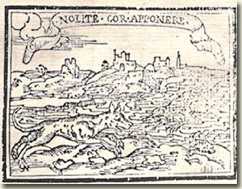
Si las riquezas vieres que corriendo
Van, como el agua, y ruedan por el suelo.
No te arrojes de bruzas, presumiendo
En ellas encharcarte, mira al cielo:
Y con la mano à tragos, y huyendo,
Refrescate, passando tan de buelo,
Como el perro sediento por el Nilo,
Temiendo no le muerda el Crocodilo.
Juan de Horozco y Covarrubias, Symbola sacra, Agrigento 1601,
Emblem 49 (Revocatus aderit)
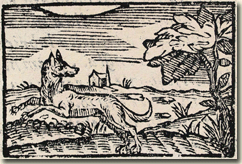
Amenaçando el deleyte
Como el can, no se detiene
Huye y si le llaman, viene.
Vt canis expulsum vitium diffugit, at istud
Non secus atque idem si reuocatur adest.
CVM variae de beatitudinis ratione fuerint antiquorum sententiae,
nihil turpius dici potuit, nihil absurdius, quàm in voluptate
constituere. Si enim ita esset, nihil impediret, quin & pecudes
beatae dicerentur. Est autem voluptas praeter modum elata laetitia,
ex Isidoro: siue, iucundus motus in sensu; Ad quam describendam
conueniet illa Isidori definitio, sordidae mentis inquinatio con
quadam ad illicita lubrica suauitate. Ex quo satis constat, quàm sit
fugienda, quamuis se sponte offerat gratuito: cùm aliàs nonnisi
dolore emi soleat. Et cuius appetentia plena est anxietatis, sicut
satietas poenitentiae. Atque ita omni modo arcendae sunt, atque
propellendae voluptates, quae sic discedunt, & fugiunt modò iterum
non vocentur. Tunc enim facilè reuocantur: iuxta similitudinem
expulsae canis, quam si fugientem videris, nunquam redituram credas:
at illa vel fugiens caput retorquet, & si denuo vocantis vocem
audiat, accedit nil timens, cum hilaritate & blanditijs. Vitia ergo
semel relegata semper longe sint à cunctis nam postliminio reuersa
integrè sua recuperant, & perniciosius nocent. |


